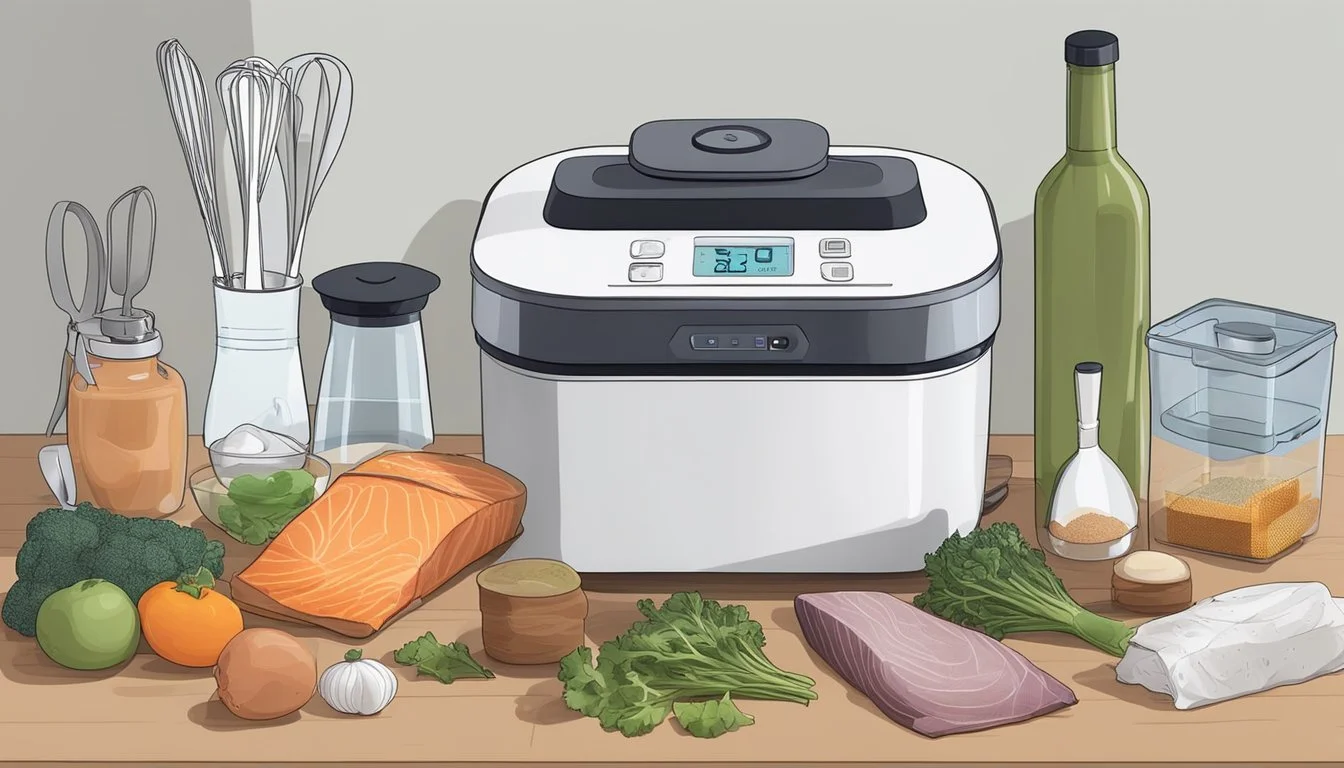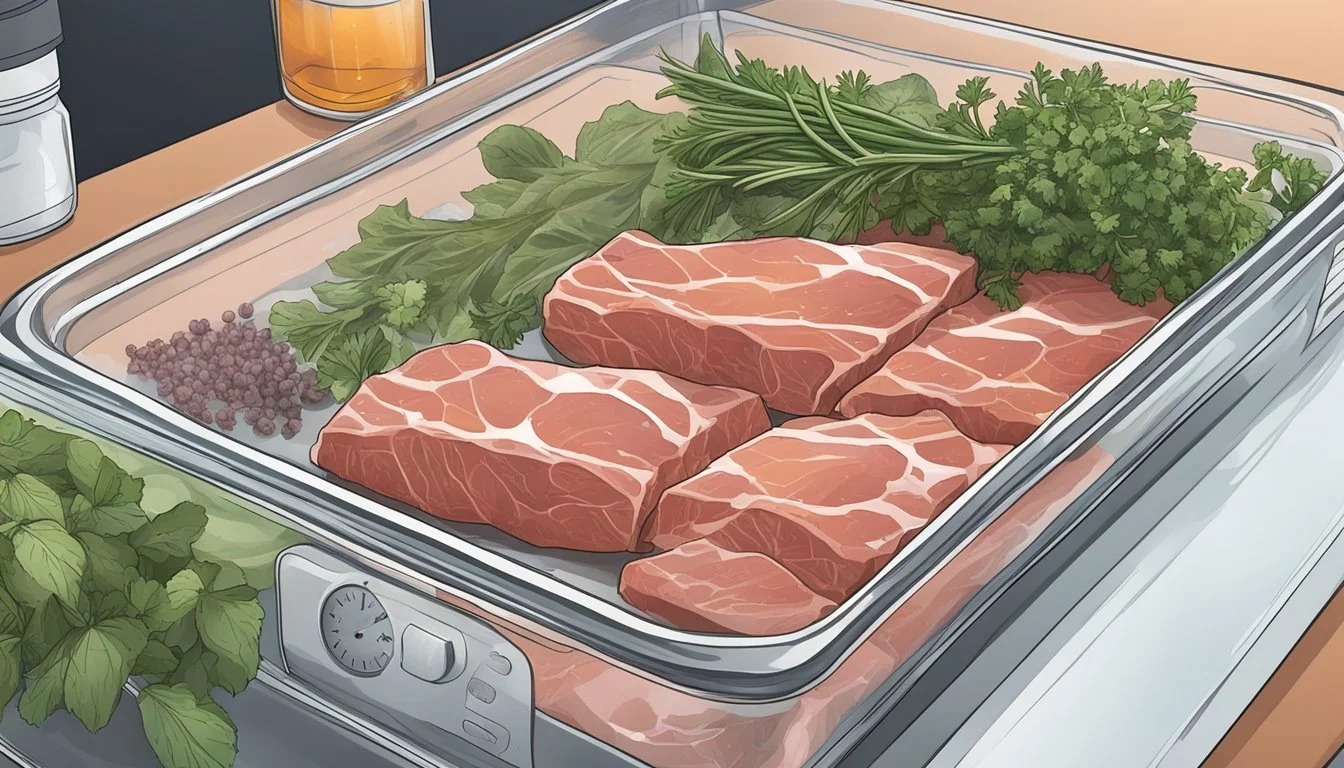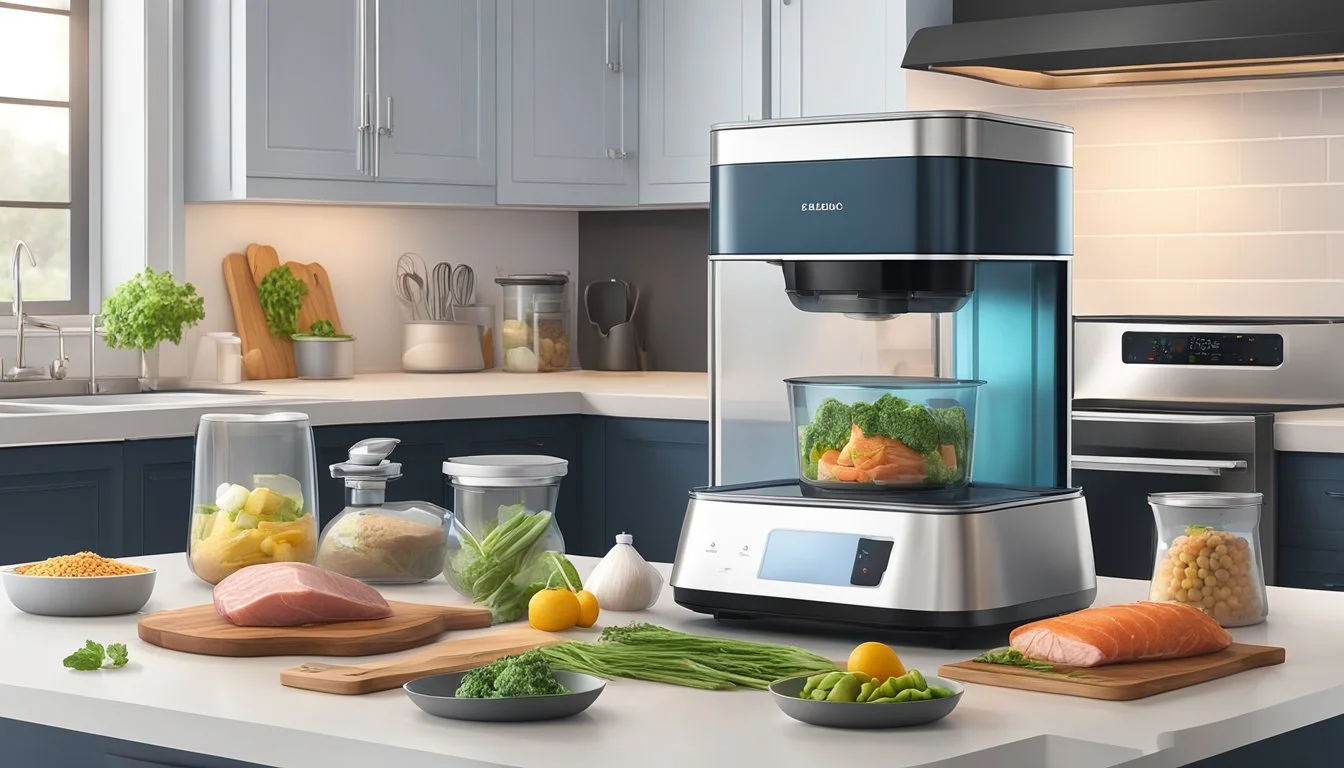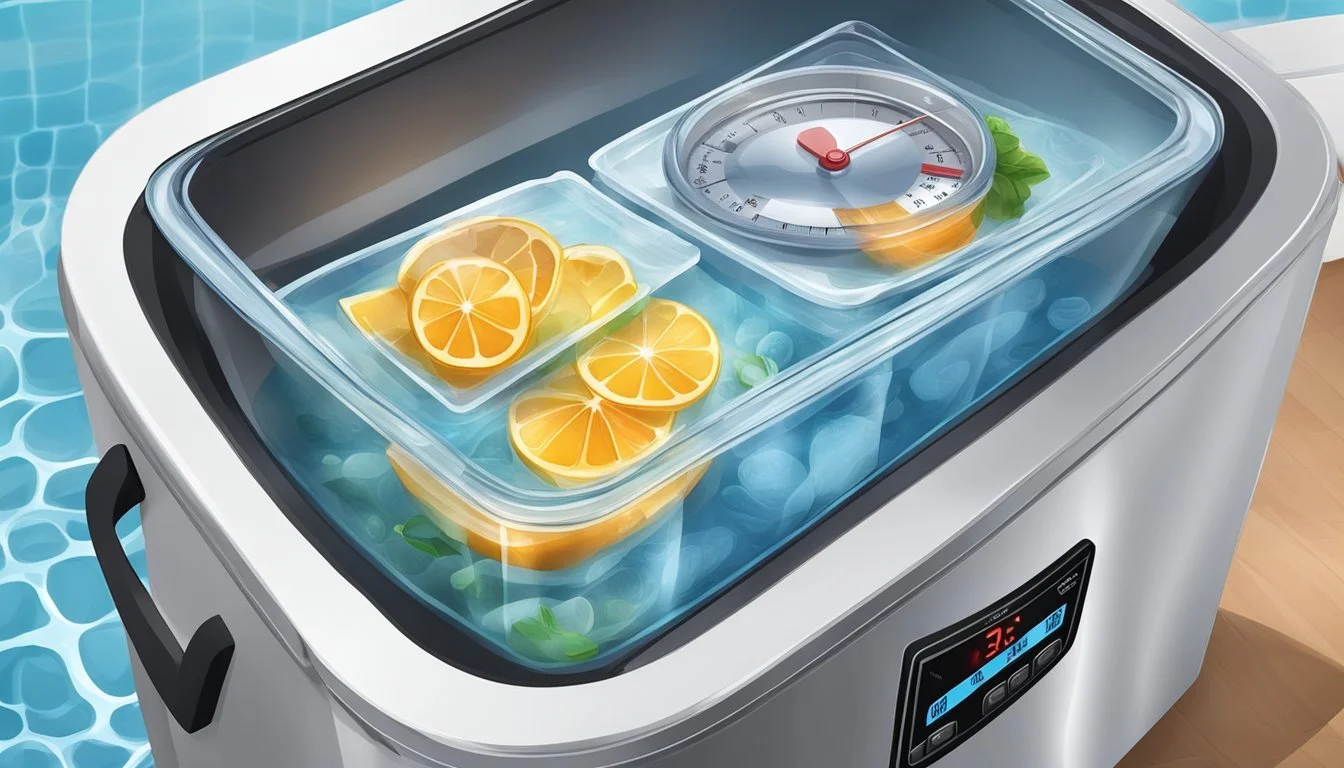The Cooler Sous-Vide
Master Precision Cooking with Everyday Kitchen Tools
Sous-vide cooking, a method once confined to the realms of high-end cuisine, has steadily made its way into home kitchens. The technique relies on precise temperature control to yield results that are consistently exceptional. Embraced for its ability to produce perfectly cooked meats, tender vegetables, and flavorful dishes, sous-vide involves sealing food in a bag and submerging it in a water bath at a controlled temperature. This process not only enhances flavor but also ensures that food is cooked evenly from edge to edge.
However, specialized sous-vide equipment can be an investment, putting it out of reach for some cooking enthusiasts. Fortunately, there's an alternative method that utilizes a tool most people have at home: a cooler. By heating water to the desired cooking temperature and ensuring it remains consistent, a cooler can mimic the sous-vide environment. This technique brings the benefits of precision cooking to a broader audience, making it an accessible option for those wanting to explore this culinary trend without purchasing specialized equipment.
Employing a cooler for sous-vide cooking involves heating water slightly above the target temperature to account for cooling once the food is added. Foods are placed in sealable bags and submerged in the water, and the cooler's insulation helps maintain the temperature for the duration of the cooking process. Although it may not boast the exactitude of a dedicated sous-vide machine, this method can still yield impressively precise and satisfying results, a testament to the inventive nature of cooking enthusiasts.
Understanding Sous-Vide
Sous-vide is a method of cooking that provides unparalleled control over cooking temperature, preventing overcooking and preserving moisture. This section highlights key insights into the process and equipment for achieving precision cooking, even on a budget.
The Basics of Sous-Vide Cooking
Sous-vide is a French term meaning "under vacuum." In this cooking technique, food is vacuum-sealed in a bag and cooked in a water bath at a precise temperature. This method ensures that the food is cooked evenly, retaining moisture and flavor, without the risk of overcooking.
Comparing Sous-Vide Devices
There are several types of devices used for sous-vide cooking, from dedicated immersion circulators to water ovens. High-end models like the Anova Culinary Precision Cooker and the Wancle Thermal Immersion Circulator offer exact temperature controls, whereas more budget-friendly models such as the KitchenBoss G320 and the VPCOK Sous Vide Cooker provide a more affordable entry point into precision cooking.
Sous-Vide Without the Price
It is possible to employ sous-vide techniques without expensive equipment. For instance, using a cooler as a makeshift sous-vide container can be an effective way to maintain the desired water temperature with the help of a reliable thermometer.
Advantages of Precision Cooking
The advantage of sous-vide lies in its precision. Cooking at specific temperatures means proteins like meat and vegetables maintain their ideal texture without losing juices. This method delivers consistent and repeatable results, whether aiming for a perfectly tender steak or delicate fish.
Safety & Temperature Control
The core of sous-vide cooking is maintaining a specific cooking temperature over time. This ensures foods are not only cooked to the perfect degree of doneness but are also safe to eat. Using an accurate thermometer to monitor the water temperature is crucial when not using a specialized sous-vide device.
Sous-Vide and Nutrition
Sous-vide cooking can have a positive impact on the nutritional value of food. By cooking at lower temperatures, it's possible to preserve nutrients that are often lost in high-heat cooking methods. Additionally, the minimal loss of juices means that proteins retain more of their natural flavor and texture.
Setting Up A Makeshift Sous-Vide
Setting up a makeshift sous-vide system enables precision cooking by closely managing water temperature without specialized equipment.
Choosing Your Cooking Container
Selecting an appropriate container is crucial for makeshift sous-vide cooking. A common option is a large pot, but for better insulation and temperature stability, a cooler is ideal. It's sufficient to drill a hole in the cooler lid sized to snugly fit a thermometer or a makeshift circulator device.
Heating the Water to the Right Temperature
Heating water to the precise cooking temperature and maintaining it throughout the cooking process are the most important aspects of sous-vide. Use a digital thermometer to check water temperature periodically. Ideally, the water should be hot enough to cook the food but not so hot as to risk overcooking.
Temperature Range (°F) Cooking Type 135-140 Medium-rare steak 145-155 Chicken 130-135 Fish
DIY Immersion Circulator Alternatives
Without an immersion circulator, one can use a heated metal rod or hot water bottles to sustain the desired temperature. These alternatives should be securely clamped to the side of the container to prevent accidents.
Alternative Sous-Vide Covers and Insulation
If a custom-drilled cooler lid isn’t possible, alternative covers, such as ping-pong balls spread across the water's surface, can minimize evaporation. Insulating the sides of the pot or cooler with towels or foam can further stabilize temperature.
Manual Temperature Maintenance
Maintaining a stable temperature without a precision cooker requires attentiveness. Adjust the heat source as needed, and use a thermometer to monitor the water temperature. Regular checks every 15-20 minutes will help manage any fluctuations.
Securing Foods in Water
Foods should remain fully submerged during cooking. Use vacuum-sealed bags or zip-top bags with air pressed out. Secure them with a binder clip or clamp to the side of the container to ensure even cooking, prevent floating, and minimize the risk of water infiltrating the bag.
Preparation & Cooking Techniques
The cooler sous-vide method transforms a simple cooler into a precision cooking bath. This section presents practical steps to prepare ingredients for cooking, seal them without specialized equipment, manage temperature accurately, and time the cook for optimal results.
Preparing Ingredients for Sous-Vide
One must be diligent while preparing ingredients for the sous-vide process. To begin, one should season meat or vegetables with selected herbs and other flavorings. Meat should be portioned to uniform thickness to ensure even cooking. Likewise, vegetables should be cut uniformly to achieve consistent doneness.
Vacuum Sealing Without a Vacuum Sealer
Option 1: Ziplock Water Displacement Method
Place the seasoned food in a quality plastic freezer bag.
Seal the bag almost entirely, leaving just enough space for air to escape.
Slowly lower the bag into water, allowing pressure to force air out.
Once the air is expelled, carefully seal the bag completely.
Option 2: Hand Vacuum Method
Partially seal a suitable freezer bag containing the ingredients.
Use a clean, small tube or straw to suck the remaining air out manually.
Quickly finish sealing the bag to lock in the vacuum effect.
Controlling Cooking Temperature
To maintain the desired cooking temperature in the cooler:
Preheat water to a slightly higher temperature than the target (about 2°F more).
Use a reliable digital thermometer to monitor water temperature.
Make temperature adjustments by adding hot water or ice as needed to stabilize the temperature during cooking.
Timing Your Cooks for Best Results
Proper timing is crucial in sous-vide cooking:
Meat:
Tender cuts: Typically, 1-4 hours.
Tougher cuts: Extended time, potentially up to 48 hours to break down connective tissues.
Vegetables:
Typically require less time than meat, around 1-3 hours, depending on desired texture.
Reference Guide: Keep a handy chart to check specific cooking times and temperatures for various foods.
It is essential to follow recipes closely for both timing and temperature to achieve desired textures and flavors.
Post-Sous-Vide Finishing Touches
After bringing meat to its perfect level of doneness through sous-vide, finishing touches are essential for enhancing flavor and texture. This section provides techniques for refining the dish after using a cooler sous-vide method.
Searing for Flavorful Crust
To transform the tender interior of sous-vide meats into a dish with a delightful variety of textures, searing is a must. Steaks and chops particularly benefit from being briefly seared in a preheated pan over high heat. Using butter or olive oil infused with herbs can introduce additional layers of flavor to that irresistible, caramelized crust.
Resting Meat After Sous-Vide
Allow the meat to rest before serving to ensure moisture redistribution throughout the meat. This rest period allows juices to be reabsorbed into the fibers, ensuring that each cut is as moist and flavorful as possible.
Using Leftover Sous-Vide Juices
Don't discard the flavorful juices left in the bag after sous-vide cooking. These juices can be reduced into a sauce or used as a base for a vinaigrette, infusing your dish with an intense depth of flavor that complements the main ingredient.
Detailing the Flavor Profile
The post-sous-vide phase is an opportune time to correct or enhance the flavor profile. One may add a glaze or sprinkle on complementary spices and finely chopped herbs to boost the taste right before serving.
Complementary Cooking Techniques
Sometimes, an additional cooking method can benefit the sous-vide main. For example, broiling or grilling can provide a smoky nuance or crispy texture that sous-vide alone does not achieve, complementing the precise doneness ensured by the sous-vide process.
Sous-Vide Recipes & Inspiration
Sous-vide cooking allows for unparalleled flavor and precision, making it a favorite for both classic dishes and creative culinary experiments. This section will guide readers through various recipes and innovative applications, focusing on meats and vegetables, ensuring that each dish achieves its utmost potential in flavor and tenderness.
Classic Sous-Vide Recipes
The tried-and-true recipes that have become synonymous with sous-vide cooking often include meats where achieving the correct doneness is essential. A medium-rare steak is a prime example, its precise temperature controlled by sous-vide to achieve a uniform cook throughout.
Chicken: Consistently moist and tender, sous-vide chicken eliminates the risk of dryness often associated with traditional cooking methods.
Eggs: Eggs reach new heights of texture; sous-vide hard-boiled eggs are known for their perfect peel and custard-like yolk.
Creative Sous-Vide Applications
Taking advantage of sous-vide's precise temperature control, chefs can experiment beyond meats, bringing vegetables like asparagus to their peak of crispness and flavor.
Vegetables: Infuse bright colors and enhance natural flavors by sous-viding with a dab of butter or a splash of olive oil.
Pork Chops: (What wine goes well with pork chops?) With careful timing, sous-vide pork chops can maintain their juiciness while fostering a safe and savory end result.
Sous-Vide for Large Gatherings
Sous-vide is a boon for serving multiple guests, ensuring every plate is as perfect as the last. It simplifies timing, a crucial factor when hosting.
Meat: Through batch cooking, large quantities of meat can be held at the perfect temperature without overcooking.
Eggs: Preparing eggs en masse becomes a breeze, offering consistent results for dishes like deviled eggs.
Experimenting with Marinades & Seasonings
The slow-cook nature of sous-vide allows for herbs and seasonings to permeate meats and vegetables, intensifying their flavors.
Steak: When a steak is vacuum-sealed with herbs, the prolonged exposure melds the flavors deeply into the meat.
Chicken: Chicken sealed with citrus or spices benefits from the extended interaction, making every bite infused with the marinade's zest.
By leveraging precise temperature control and time, sous-vide cooking opens up a world of flavors and textures, whether the chef is aiming for a perfectly medium-rare steak or looking to infuse a chicken breast with aromatic herbs. Its versatility makes it an invaluable method for any kitchen looking to elevate their culinary game.
Advanced Sous-Vide Techniques
In the realm of precision cooking, consistency, scalability, and exploration of diverse cuisines are paramount. Techniques that fine-tune temperature control and enhance cooking performance are fundamental in transcending the basics of sous-vide cooking.
Improving Sous-Vide Consistency
Temperature Control: The key to consistent textures and flavors in sous-vide cooking is maintaining an exact temperature throughout the cooking process. Users can leverage a high-end circulator such as the Anova Culinary Sous Vide Precision Cooker Pro, which offers control to within a tenth of a degree, to achieve uniform results across different batches.
Circulation: Effective water circulation eliminates hot or cold spots in the water bath, ensuring that each part of the food item cooks evenly. Precision cookers with powerful circulators maintain this consistency, vital for advanced sous-vide cooking techniques.
Scaling Sous-Vide for Restaurant Use
Cooking Performance: For restaurant settings where volume is critical, equipment like the SousVide Supreme can handle larger quantities of food while not compromising on performance. This ensures that each dish meets the restaurant's quality standards.
Capacity: A larger immersion circulator compatible with up to 30L tanks can serve the needs of a busy kitchen. Its ability to maintain precision in temperature across larger volumes is necessary for scalability in commercial use.
Exploring Sous-Vide for Other Cuisines
Innovation in Flavors: Sous-vide is not just for steaks and eggs. Chefs are using this technique for ingredients central to various cuisines, experimenting with spices and marination times to infuse dishes with deeper flavors.
Texture Exploration: Different cuisines require attention to the uniqueness of textures. With sous-vide, chefs can achieve the desired tenderness or firmness specific to cultural dishes, all the while preserving the integrity of the original cuisine.
The Future of Home Sous-Vide Cooking
As sous-vide becomes a staple in the modern kitchen, its evolution is shaped by technology, user experience, and environmental considerations. The next generation of home sous-vide cooking promises a blend of convenience and sophistication with sustainability at its core.
Smart Kitchen Integrations
Integrating sous-vide devices, like the Anova Culinary Precision Cooker, with home automation systems is the next frontier. Manufacturers are creating sous-vide machines with Bluetooth and Wi-Fi capabilities allowing them to seamlessly communicate with other smart kitchen appliances. Users can expect future models to be controlled via voice commands or a central kitchen app, creating a unified cooking experience.
App Control: Sous-vide machines with built-in app control for monitoring and adjusting cook times and temperatures.
Voice Activation: The integration of voice command technology for hands-free operation.
Consumer-Electronics Crossover
Sous-vide equipment like the Joule Turbo and the Anova Culinary Precision Cooker Nano showcases a trend where kitchen gadgets borrow from the aesthetics and functionality of consumer electronics. Much like stylish laptops, future sous-vide devices will likely prioritize not only performance but also design, becoming a countertop-worthy appliance. The possibility of crossover technology could also mean sous-vide devices that offer additional capabilities beyond cooking.
Multifunctional Devices: Sous-vide equipment with features typical of consumer electronics, such as touch displays and multimedia functions.
Aesthetic Appeal: Sleek, minimalist designs that blend with modern kitchen decor.
Sustainable and Cost-Efficient Cooking
Energy efficiency is a growing concern for consumers, and manufacturers are responding by creating sous-vide devices that utilize less power without sacrificing performance. Upcoming models could be engineered to reach desired temperatures quicker and maintain them more efficiently.
Energy Efficiency: Advanced thermal insulation and precise temperature control mechanisms.
Price: Competitive pricing achieved through energy-saving features that reduce running costs.
As home cooks look for restaurant-quality results with minimal environmental impact, the future of home sous-vide cooking is focused on smart, stylish, and sustainable solutions.
Choosing Your Equipment
In the realm of sous-vide cooking, selecting the right equipment is pivotal to kitchen success. The devices vary by design, price, and technology, catering to novices and professional chefs alike. Here, the focus is on understanding which sous-vide tools best meet individual culinary needs and how to strike a balance between cost and performance.
Sous-Vide Equipment for Beginners
For beginners, the Anova Culinary Sous Vide Precision Cooker Nano presents an accessible entry point. The Nano is noteworthy for its user-friendly interface, which boasts a simple LCD screen. At a competitive price point, this immersion circulator prioritizes ease of use without sacrificing precision, making it an excellent choice for those starting their sous-vide journey.
Professional-Grade Sous-Vide Tools
Chefs seeking more robust options might gravitate towards the Anova Culinary Sous Vide Precision Cooker Pro. This powerhouse can maintain temperature across larger volumes of water, signifying its capacity for extensive use in a professional setting. With a 1,200-watt output, the Precision Cooker Pro stands as a testament to performance under rigorous demands.
Comparing Popular Sous-Vide Brands
Anova:
Precision Cooker Nano
Precision Cooker Pro
Breville:
Joule Turbo
When comparing brands, Anova and Breville emerge as prominent players. The Breville Joule Turbo is a standout with its sleek, compact design and an app-driven operation. Between these brands, consumers should consider factors like water capacity, temperature accuracy, and whether they prefer manual controls or app connectivity.
Evaluating Price vs. Performance
Here's how two popular models weigh up:
Brand Model Price (Approx.) Key Features Anova Precision Cooker Nano $100 User-friendly, precise control Breville Joule Turbo $200 Compact, app-enabled
Price and performance are often directly correlated, but value differs per user. The Instant Pot, though not a dedicated sous-vide device, offers versatility and a friendly price. In terms of dedicated devices, the Nano is cost-effective for its capabilities, while the Joule may cost more but offers advanced features and a more potent heating element for faster water heating.
Troubleshooting & Maintenance
In the realm of sous-vide cooking, precision is paramount. This section is dedicated to ensuring the stability and accuracy of your sous-vide cooking through effective troubleshooting, diligent maintenance, and understanding technical support avenues to ensure longevity of your equipment.
Common Sous-Vide Issues and Fixes
Inaccurate Temperatures: Ensure the immersion circulator's temperature is calibrated correctly. If discrepancies occur, recalibrate according to the user guide to maintain accuracy.
Unstable Water Bath: Check the water level and make sure it's between the minimum and maximum markers. Additionally, use a lid or plastic wrap to minimize water evaporation and maintain temperature stability.
Cleaning and Caring for Your Equipment
Routine Maintenance:
Wipe down all accessible stainless steel parts with a damp cloth regularly.
Create a mixture of white vinegar and water for a descaling bath to prevent mineral buildup.
Post-Cooking Cleaning:
Remove any food debris from the stainless steel skirt and other parts immediately after use.
Do not immerse electronics in water; clean them with a slightly damp cloth.
Dealing With Technical Problems
When facing issues with app control, ensure the device's firmware is updated and the phone's Bluetooth is functioning properly.
If the sous-vide machine malfunctions, refrain from attempting repairs as there are no user-serviceable parts. Instead, consult the user manual or contact customer support.
Warranty and Replacement Policies
Manufacturer's Warranty:
Most sous-vide machines come with a warranty. Check the duration and coverage, which typically includes defects in materials and workmanship.
Replacement Procedures:
If the device is within the warranty period and encounters an issue covered by the warranty, contact customer support for assistance with a replacement, referring to your purchase receipt and warranty information.
For expired warranties or issues not covered, consider the price of repair against a new purchase.









